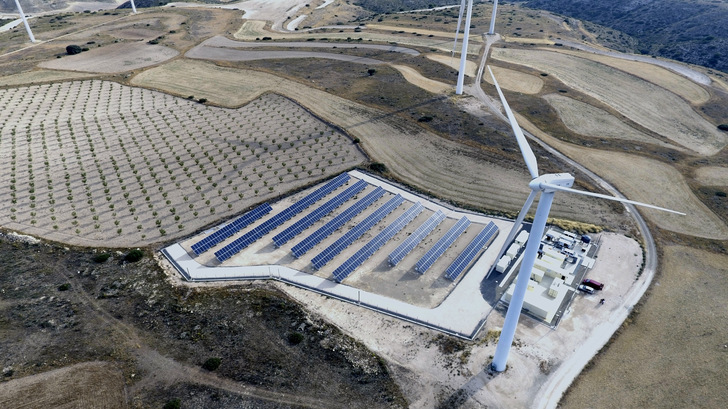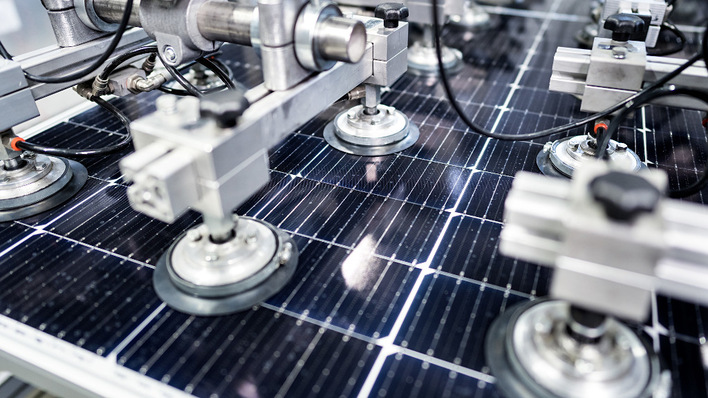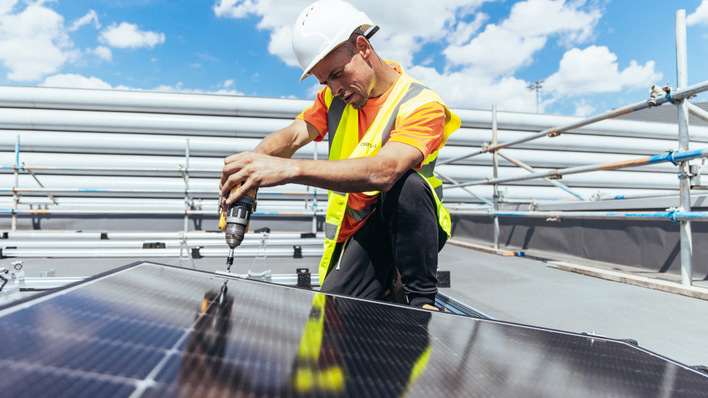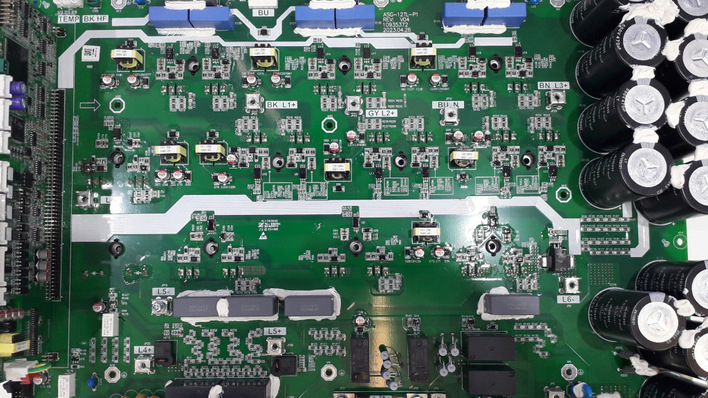Combining solar and wind parks with large battery storage systems at a single site, otherwise known as co-location, offers several advantages. For operators, it reduces risk by diversifying revenue streams, protecting against price cannibalisation, and enabling generation or feed-in to shift to evening hours. The economic viability of battery storage improves through cost savings from a shared grid connection and faster grid access. For the power system, benefits include fewer grid bottlenecks, reduced curtailment of plants and more efficient use of limited grid capacity.
So far only small market share for hybrid systems
However, the market for renewable co-location projects in Europe is still in its early stages. According to Aurora Energy Research, solar and wind farms with a combined capacity of nearly 1.2 gigawatts (GW) were operating in Europe in 2023 alongside large-scale battery storage. PV plus battery storage led the way with 724 megawatts (MW), followed by onshore wind plus storage at 475 MW. According to SolarPower Europe, 11 percent of the 0.8 GW of large-scale battery storage systems totalling 1.1 gigawatt-hours (GWh) installed in Germany between 2021 and 2023 were combined with renewable energy plants, mainly solar parks. In the UK, 12 percent of wind and solar farms were co-located with battery storage or electrolysers, according to an April 2024 report by industry association Renewable UK.
Read the free hybrid special now
However, experts and industry representatives report a sharp rise in demand for large-scale battery storage and co-location projects. In Germany, project developers have submitted grid connection requests for 161 GW of battery storage capacity – one hundred times more than the 1.6 GW currently installed. SolarPower Europe also forecasts strong growth in large-scale battery storage in its European Market Outlook for Battery Storage 2024–2028. In the medium scenario, total installed capacity is expected to reach 78 GWh, more than double the 2023 figure of 35.8 GWh.
Growing interest in co-location projects
In a high-growth scenario, installed battery capacity in Europe is expected to reach 135 GWh by 2028. Large batteries, particularly grid-scale systems, also known as utility-scale storage, will lead the market. Their share of new installations is projected to rise to 45 percent by 2028, more than double the 2023 level of 21 percent. As a result, interest in co-location projects is also increasing, according to analysts Jannik Carl and Eva Zimmermann of Aurora Energy Research. Almost all large-scale PV projects are now combined with battery storage, says Stefan Müller, Chief Operating Officer (COO) of EPC provider Enerparc.
Co-located solar park for a resilient grid completed in Sweden
Valerii Lazarev, Projects Bankability Manager at WElink Energy, identifies negative electricity prices during peak times, grid bottlenecks and high grid access costs as key drivers for co-location projects. EPCs can benefit from hybridising existing solar projects by flattening the production curve and delivering energy on demand – and therefore at higher prices. This can be achieved with relatively low investment, as no new and costly grid connection is required.
Largest hybrid plant in Portugal
The international developer, based in Ireland, is currently expanding a 219 MW solar park in Vaquieros, southern Portugal, into a co-location facility with a capacity of over 1 terawatt-hour, according to Lazarev. Commissioned at the end of 2021, the park will be enlarged in phases. First, an additional 50 MW of PV capacity will be added, followed by a 165 MW wind farm and a 100 MW/400 MWh battery storage system. Construction is scheduled to begin in the second half of 2025 and is expected to be completed by the end of 2027.
A how-to of ombining agri-PV with wind power and storage
Europe’s largest co-location power plant is currently under construction by Spanish energy producer Endesa, also in Portugal, in Pego (province of Santarém). The project combines a 365 MW PV plant, a 264 MW wind farm and a 168 MW battery storage facility. In addition, a 500 kW electrolyser will be installed to produce green hydrogen using surplus energy that cannot be absorbed by the battery system.
Further cost decline an important driver
The continued decline in costs, especially for photovoltaics and battery storage, is another key driver of co-location projects. According to a July 2024 study by the Fraunhofer Institute for Solar Energy Systems (ISE), the levelised cost of electricity (LCOE) for solar parks in Germany ranges between 4.1 and 6.9 euro cents per kilowatt-hour. For combined ground-mounted PV systems with battery storage, the LCOE is between 6.0 and 10.8 cents per kilowatt-hour.
Europe sees rapid expansion of large-scale battery systems
If battery prices fall to the projected range of 180 to 700 euros per kilowatt-hour by 2045, the ISE expects production costs for ground-mounted PV battery systems to drop to between 3.1 and 5.0 euro cents per kilowatt-hour. By comparison, fossil fuel power plants are already significantly more expensive: lignite-fired plants cost between 15.1 and 25.7 cents, hard coal between 17.3 and 29.3 cents, combined-cycle gas plants 10.9 to 18.1 cents and flexible gas power plants 15.4 to 32.6 cents per kilowatt-hour. Nuclear power ranges from 13.6 to 49.0 cents per kilowatt-hour.
Reduce construction and operation costs by 50 %
According to Aurora Energy Research, the actual increase in profitability (IRR) currently achievable by combining a solar power plant with a battery storage system in key European markets ranges from one to just over two percent. The IRRs of standalone solar parks were compared with those of projects co-located with battery storage.
Podcast: Prospects and pitfalls for investments in solar and large battery projects
RenewableUK points out the high potential cost advantages of co-location projects if regulatory barriers are removed and approvals are simplified. Combining PV projects with battery storage at the same grid connection point could reduce construction and operating costs by 50 percent. In addition, a more flexible energy system with the integration of storage in the UK would save 16.7 billion pounds (19.8 billion euros) in electricity system costs annually by 2050, which would also benefit electricity customers.
Complexity and regulation as obstacles
There are several reasons why co-location projects often struggle to realise their full cost-saving potential in practice, and why uptake remains slow. “In addition to regulatory issues, this combination of technologies is extremely complex in terms of structure and commercialisation. Business models must be assessed on a case-by-case basis and, depending on local conditions, a standalone project may be more attractive than a co-location one,” says Philipp Kraemer, Director Strategic Growth & Digitisation at CCE.
Solar Investors Guide: Storage systems to revolutionise the grid
In Germany, the so-called exclusivity principle under the Renewable Energy Sources Act (EEG) has hindered the economic viability of solar and wind farms combined with battery storage. It stipulates that EEG-subsidised plants may only be charged with green electricity year-round; using grid electricity would result in the loss of EEG plant status and associated subsidies. This severely restricts the profitable and flexible operation of storage systems co-located with solar or wind farms – particularly for shifting feed-in to high-price hours or providing balancing energy, which requires drawing power from the grid.
UK, Ireland and Italy already further ahead
According to the Solar Package I, from June 2025 it should be possible to switch the operating mode every two months, and from June 2026 to charge the storage system both from the grid and the renewable energy system in parallel. However, Aurora analyst Eva Zimmermann warns of possible delays in the regulation taking effect in Germany, as the Federal Network Agency – responsible for implementation – has yet to approve a measurement concept. Other European countries, including the United Kingdom, Ireland and Italy, which already allow flexible operation of co-location systems, are further ahead in this regard, says Zimmermann.
Expert view – battery storage as PV business model
Intersolar Europe, taking place this year from 7 to 9 May, offers a comprehensive overview of the latest products, technologies and solutions, along with key trends in the field of PV hybrid power plants. At the accompanying Intersolar Europe Conference, an English-language session titled “Hybrid PV Power Plants II: Strategies for Matching Energy Generation & Power Demand” will run from 2:00 to 3:30 p.m. on Wednesday, 7 May. On Thursday, 8 May, the topic will also be featured in an English session at the Intersolar Forum (Hall A3, Booth A3.150) from 15:00 to 16:30. (hcn)









